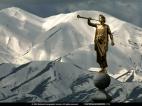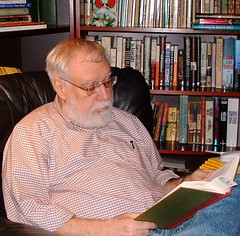Listen, if you want to chat, Moses is that guy feeding his camel over there by the tree

We'll skip the Mormon cartoons—Here’s an interesting little problem. What if people invented time machines and could go back into the past, let’s say to the reign of Ramses II, and discovered that the Hebrew slaves were only a couple of thousand in number and they fled into the desert under the leadership of a guy named Moses. The Pharoah, figuring that a few thousand slaves weren’t worth bothering about, lets them go. End of story. If you are Jewish you just had a cornerstone of your faith undermined by science. Or, maybe they go back to Jerusalem in during the reign of the Emperor Tiberius and found that a carpenter in Nazareth named Jesus had indeed been executed outside of Jerusalem, but his body was thrown into a common ditch grave and never seen again. If you are Christian, you’ve got a problem.
It has happened to the Mormons. Mark Twain once described the Book of Mormon as “chloroform in print.” I thought the Mormon Tabernacle Choir was living proof that if you put together 200 mediocre singers you just got a loud mediocre chorus. Whatever. One of the main precepts of the book is that North American Indians were descendent from one of the lost tribes of Israel and came to this continent in 600 B.C. They built a civilization here, but split into two warring factions. By 385, one group, the idol-worshiping Lamanites, defeated the God-fearing Nephites, and they were the ancestors of the Indians. It's one reason the Mormons have gone to great lengths to convert the Indians—to bring them back into the God-fearing fold.
Along comes DNA testing and it turns out the Indians came from Asia with no sign whatsoever they ever set foot in the Middle East. That’s a whoops. The Mormons, like conservative Christians and Orthodox Jews, take their holy book as literally true—every word. Since the Church of Latter Day Saints has converted millions of Indians based on the premise they were the people described in the book, this is a major problem. Mormonism, indeed, one of the fastest growing religions in the world, gets much of its new strength from those regions where the Indians live. At least one missionary has quit, no longer capable of believing in what he was doing. It is not known how many others may have.
Much of the DNA work comes from something of an apostate, Simon G. Southerton, a molecular biologist and former Mormon bishop in Australia. Southerton notes that DNA testing of Jews throughout the world shows a strong common Middle Eastern origin. No one doubts their origin. But when he tested the indigenous people of the Americas, including maternal DNA lines from 7,300 Indians from 175 tribes, he came up with no sign of Middle Eastern origin. They came from eastern and central Asia.
The DNA evidence isn’t the only problem with the Book of Mormon. It is full of anachronisms, such as the domestication of farm animals, which never happened, and despite millions of dollars in research, Mormons have found not a single bit of archeological evidence to support the ancient civilization theme.
Church leaders have dismissed the acknowledgment of the scientific evidence “heresy,” of course. And outsiders like me might think such a blow might at least put a crack in the faith. But probably not. As one professor, quoted in the Los Angeles Times noted: “This may look like the crushing blow to Mormonism from the outside, but religion ultimately does not rest on scientific evidence, but on mystical experiences. There are different ways of looking at the truth.” Mormons have barraged the web with responses, including some totally discounting the DNA evidence. Search Google for “Mormon” and “DNA’ and you’ll see how effective they have been. They have also launched a major attack on Southerton. Southerton has fired back.
But since Mormon leaders insist the book can’t be wrong, they seem to have a conundrum. They claim the book can’t be proven or disproved by science. But of course, it has.

